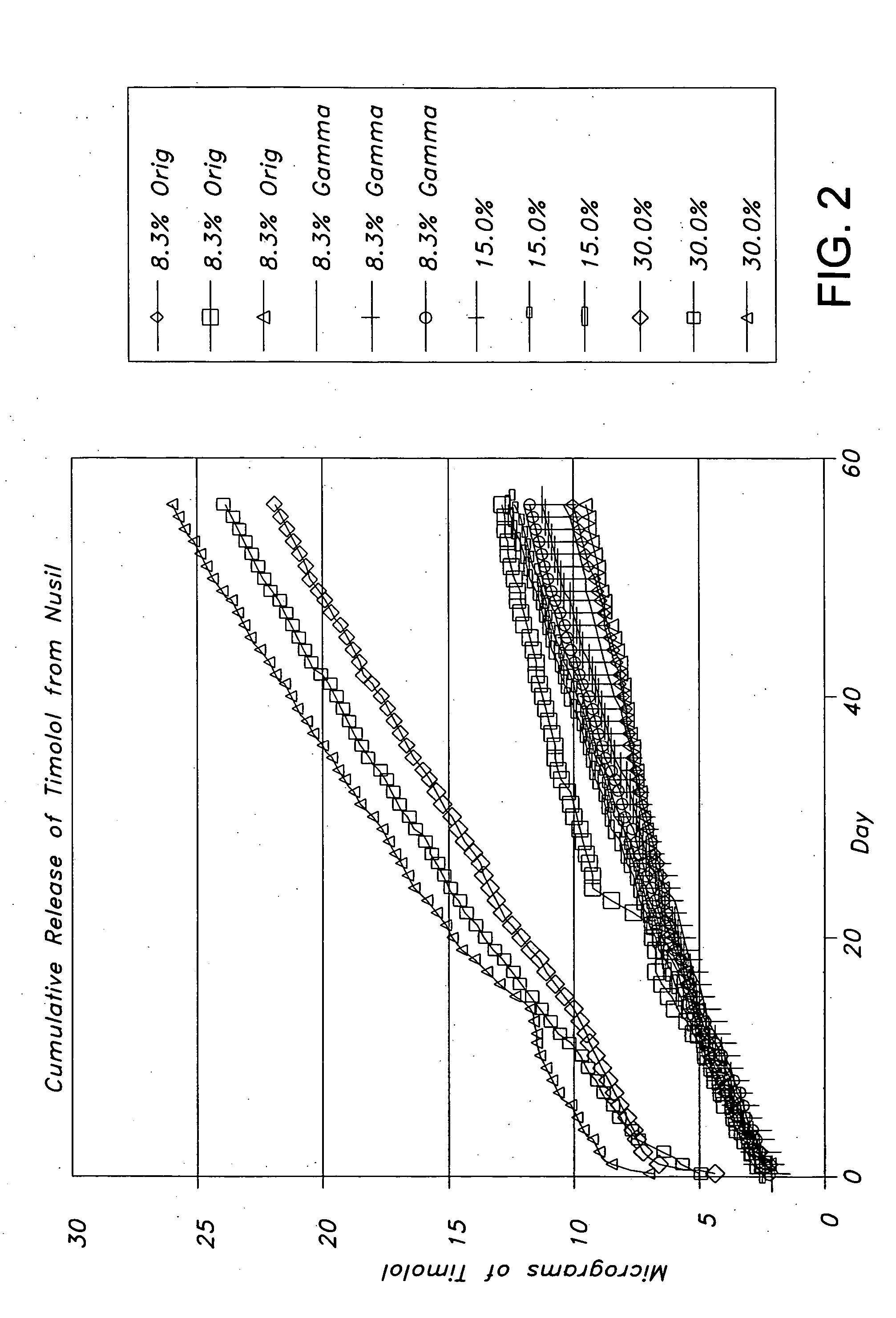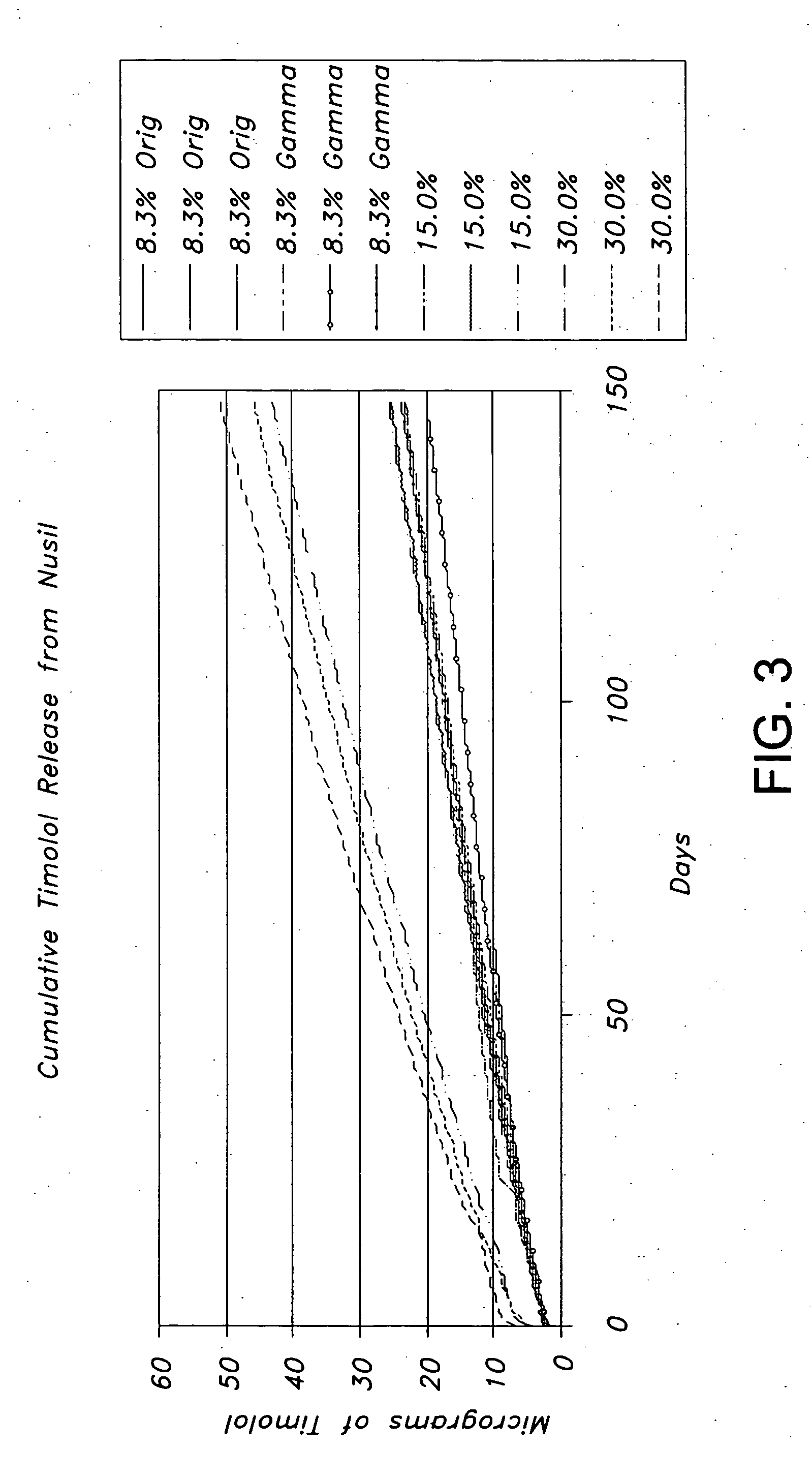Drug delivery systems
- Summary
- Abstract
- Description
- Claims
- Application Information
AI Technical Summary
Benefits of technology
Problems solved by technology
Method used
Image
Examples
example 1
Synthesis of Diallyl Triethylene Glycol Terminated Disiloxane
[0066] To a 1 L round bottom flask equipped with a magnetic stirrer and water condenser is added tetramethyldisiloxane (10 grams, 0.074 moles), diallyl terminated diethylene glycol (69 grams, 0.37 moles), tetramethyldisiloxane platinum complex available from Gelest, Inc. (Morrisville, Pa.) (40 mL), dioxane (200 mL) and anhydrous tetrahydrofuran (200 mL) under a nitrogen blanket. The reaction mixture is heated to 75° C. and the reaction was monitored by IR and 1H-NMR spectroscopy for loss of silicone hydride. The reaction is completed in 4 to 5 hours of reflux. The resulting solution is placed on a rotoevaporator to remove tetrahydrofuran and dioxane. The resultant crude product is passed through a column of silica gel using standard chromatography techniques. The collected solution is again placed on the rotoevaporator to remove solvent and the resultant clear fluid is placed under vacuum (>0.1 mm Hg) at 50° C. for four h...
example 2
Synthesis of a Diallyl Terminated Siloxane
[0067] To a 500 mL round bottom flask under dry nitrogen is added D4 (octamethylcyclotetrasiloxane) (93.59 grams, 0.316 moles) and the disiloxane (6.36 grams, 0.0126 moles) prepared in Example 1. Trifluoromethane sulfonic acid (0.25% w / w) is added as initiator. The reaction mixture is stirred 24 hours with vigorous stirring at room temperature. Sodium bicarbonate (10 fold excess based on trifluoromethane-sulfonic acid) is then added and the reaction mixture is again stirred for 24 hours. The resultant solution is filtered through a 0.3% Teflon® filter. (E.I. DuPont De Nemours & Co., Wilmington, Del.). The filtered solution is vacuum stripped and placed under vacuum (>0.1 mm Hg) at 50° C. to remove the unreacted silicone cyclics. The resulting diallyl terminated siloxane is believed to be a viscous, clear fluid.
example 3
[0068] To a 1000 mL round bottom flask under dry nitrogen is added D4 (77.14 grams, 0.26 moles), D4H (tetramethylcyclotetrasiloxane) (20.85 grams, 0.087 moles) and hexamethyldisiloxane (1.86 grams, 0.0138 moles). Trifluoromethane-sulfonic acid (0.25% w / w) is added as initiator. The reaction mixture is stirred 24 hours with vigorous stirring at room temperature. Sodium bicarbonate (10 fold excess based on trifluoromethane-sulfonic acid) is then added and the reaction mixture is again stirred for 24 hours. The resultant solution is filtered through a 0.3μ Teflon® filter (E.I. DuPont De Nemours & Co., Wilmington, Del.). The filtered solution is vacuum stripped and placed under vacuum (>0.1 mm Hg) at 50° C. to remove the unreacted silicone cyclics. The resulting silicone hydride functionalized siloxane is a viscous, clear fluid.
PUM
 Login to View More
Login to View More Abstract
Description
Claims
Application Information
 Login to View More
Login to View More - R&D Engineer
- R&D Manager
- IP Professional
- Industry Leading Data Capabilities
- Powerful AI technology
- Patent DNA Extraction
Browse by: Latest US Patents, China's latest patents, Technical Efficacy Thesaurus, Application Domain, Technology Topic, Popular Technical Reports.
© 2024 PatSnap. All rights reserved.Legal|Privacy policy|Modern Slavery Act Transparency Statement|Sitemap|About US| Contact US: help@patsnap.com










